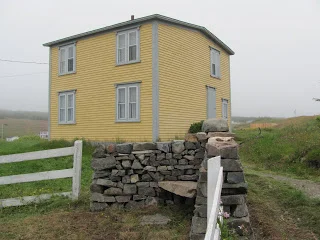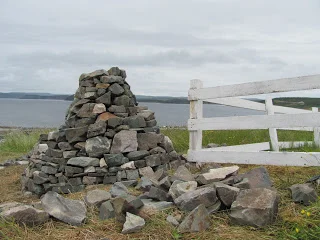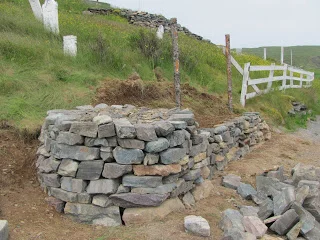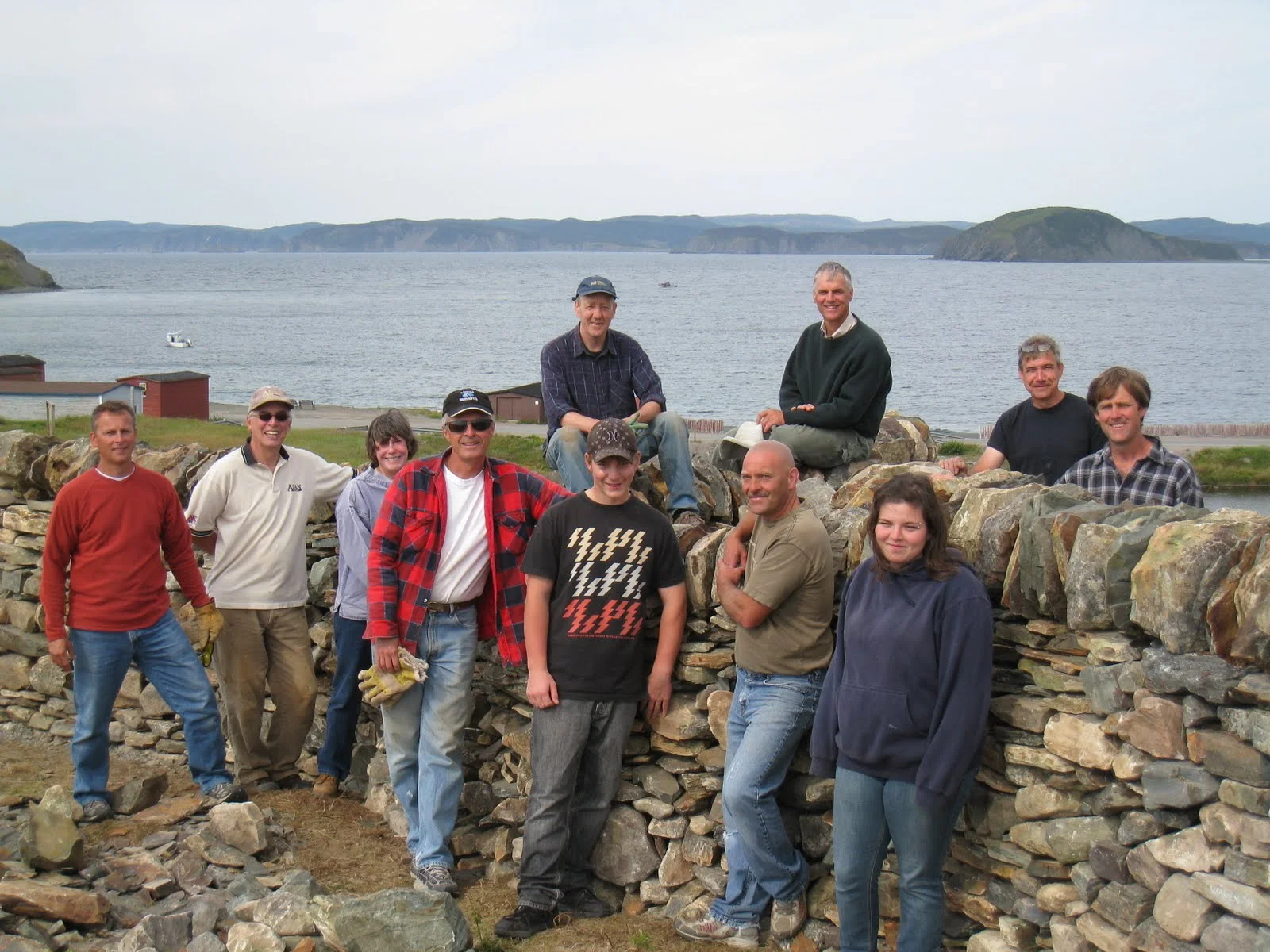Newfoundland’s well deserved nickname is “The Rock.” You can’t go anywhere on the island without running into some new geologic wonder to explore. An ample supply of loose building stone is what first drew me to Canada’s easternmost province but in the five, annual pilgrimages I’ve made to Newfoundland since 2010 I’ve discovered that there’s much more going on there.
Read MoreThe English Harbour fog machine has been churning out invisibility for a solid 24 hours. Before I arrived here a week ago the southwest wind that funnels moisture off Trinity Bay into the land bowl above the harbor had kept the village cloaked in a cotton wool shroud for fourteen days. Fortunately, the recently concluded environmental art workshop maintained blue skies above for each and every one of its five days. There were long-distance views in every direction from the headlands where the six participants worked on their dry stone installation.
Read MoreThe purpose of the workshop is to discover terrestrial habitats, artifacts, microcosms and vistas that excite curiosity and wonder about a place, identify existing order and disorder for the purpose of exploring ways art can be an evolutionary partner with the environment, and to seek out conditions conducive to the development of creative interrelationships with the natural world. The workshop will take a hands-on approach to making art that springs from, and is absorbed by, its surroundings.
DATE: Sunday July 27 - Thursday July 31, 2014. Participants interested in a 2-day workshop, are welcome to join in on the Wednesday/Thursday of the 5-day workshop.
LOCATION: English Harbour Arts Centre, Trinity Bay, Newfoundland, Canada.
Reflecting on the recently completed 2-day workshop at English Harbour Art Centre, I begin to see that perhaps the most useful function I perform as a walling instructor is offering permission to those in attendance to try something new. For a participant, the workshop setting is a green light at an intersection that otherwise would be blinking red. Because the building site has been prepared with footings dug, guidelines strung and stones laid out on the ground, around, the usual impediments to getting started building a wall have been removed. A participant feels free to act and is encouraged to begin.
Read MoreA distant foghorn, waves lapping against the harbor shore and the “blow” from a humpback whale surfacing in the bay; these are the sounds that often greet visitors coming to English Harbour, Newfoundland. This summer’s workshop goal will be to create a companion piece to the “Mock Maze” that was built in 2012. Participants will collaborate on creating a design, and then construct it on the grounds of the art center.
Read MorePast workshops have sketched a wave on the footprint of a derelict old field wall by establishing a guide frame with rope and artist easels, and bringing stones to points just under the line. Another group hiked to a remote beach and made a circle of stones on the crest of the high-water mark. It was only a visible as a piece of environmental art from the air. The English Harbour village and coastal cliffs along the famous Skerwink Trail were also viewable from Dave Paddon’s float plane.
Read MoreEach morning a pair of loons fly from the high forest pond behind the house to the wide ocean bay at the bottom of the road. In the evening they make a return flight. They punctuate their daily routines with an intermittent call and response, stuttering laughs that draws me out onto the deck to watch them wing past. This is high entertainment in the TV and internet-free environment I’ve been living in the past two weeks. The radio here is powered by a hand crank. After five minutes of broadcast the signal cuts out and I have to decide if the listening is worth the effort to recharge the battery.
Read MoreA collaborative design process culminating in the hands-on creation of a dry stone structure. Instruction in design will include site assessment, 3-D modeling and guide frame set up. Instruction in building with loose stone will include identifying each stone’s best use, applying the four basic principles for strong construction, and practicing safe methods for shifting and lifting stone. One day of the workshop will be devoted to working in nature to create a temporary environmental art piece.
Read MoreThe dates have been set for the two English Harbour Arts Centre workshops I will be instructing this coming summer. Five-day and two-day long courses, July 29 - August 2 and August 4 -5, will focus on constructing new dry stone walls on the grounds of the art centre. The finished works will represent pieces of a grand puzzle that EHAC hopes to realize in the near future. The dream is to build a dry stone maze on the majestic headlands of Trinity Bay.
Read MoreMy thanks go out to all those who made the stone workshops a success. Community members collected stone by the snowmobile trailer load, or by filling up the back of their Subaru. Members of the Centre’s board of directors promoted the workshop, participated in it and brought baked goods and coffee to fuel progress. For those who dug sod, barrowed stone, nailed together guide frames and crafted the works I’m forever grateful for your toil and alacrity.
Read MoreThe dry stone workshops at English Harbour have been treated to buffeting winds, lightning storms, muffling fog and dazzling sunshine over these past two weeks. Participants have gone from working in tee shirts to suiting up in insulated rain-gear. Whatever the weather conditions of the day (or hour) it’s been exhilarating working on the Newfoundland coast. The wide vistas of boreal forestland and ever-changing seascape have made a dramatic backdrop to our dry stone activities.
Read MoreWhile other parts of Canada are experiencing record high temperatures, here on the east coast of Newfoundland we go about in wool sweaters and windbreakers. Lightning storms have made quick visits overhead in the nighttime. Strong winds blow intermittently through the day. But always, in the past week, there has been fog. Time stands still when the quality of light remains the same from dawn to dusk. It’s the color of pewter tinged with green from the landscape of meadow grass and spruce forest. And always the mournful moan of the foghorn in the background calling out from the coastal headlands; a sound I don’t so much hear, as feel in my body like the rise and fall of a breath.
Read MoreSince my arrival in English Harbour under clear blue skies three days ago, the fog has crept in and kept our dry stone walling workshop blanketed in degrees of gray. However, the enthusiasm of all six participants has been nothing less than rainbow bright. They started out on Monday brainstorming their way to a design and plan of attack to begin building the first of four corner features for a new fence around the arts centre. On Tuesday they completed a six-sided base for a stone lantern and a short length of retaining wall. Today we’ll keep a watch out for whales. Maybe the three humpbacks that were feeding on capelin in the harbor on Monday will be back.
Read MoreThe road to a project’s completion is often a long and winding one. That’s why it’s worth taking time along the way to enjoy the view. The installation I’ll be doing at TICKON in Denmark later this summer began last year with an invitation from the art park to submit a proposal. Over the months, conversations and emails have taken the proposal through a series of development where I now feel that all the parts are in place to begin the work.
Read MoreCultivated land is a handmade environment. In centuries past, the face of Newfoundland was shaped by domestic agricultural activity. While many of the stone walls built during those times have lost their stature as fences, their presence remains a defining characteristic of the land. The close attention that farmers paid to their surroundings is comparable to the awareness artists bring to their work. Dry stone construction is a logical medium of expression for an artist working in the landscape.
Read MoreThe process of creating a work of art in the landscape involves a lot of physical activity, to be sure, but no less crucial to its conception is a continual winnowing of “knowns” and “unknowns.” At first, the “unknowns” are many. It might be daunting if it wasn’t equally exciting. Questions are stimulating, and answers to them, rewarding.
Read MoreDan and provincial folklorist Dale Jarvis will chat at the Two Whales Coffee Shop in Port Rexton about the tradition and the art of stonework, and the place that dry stone wall building holds in the heritage of Newfoundland.
Read MoreAngela Antle, Producer/Host, Weekend Arts Magazine for CBC Newfoundland and Labrador, interviewed Dan last week about the workshops at the English Harbour Arts Centre.
Read More
















